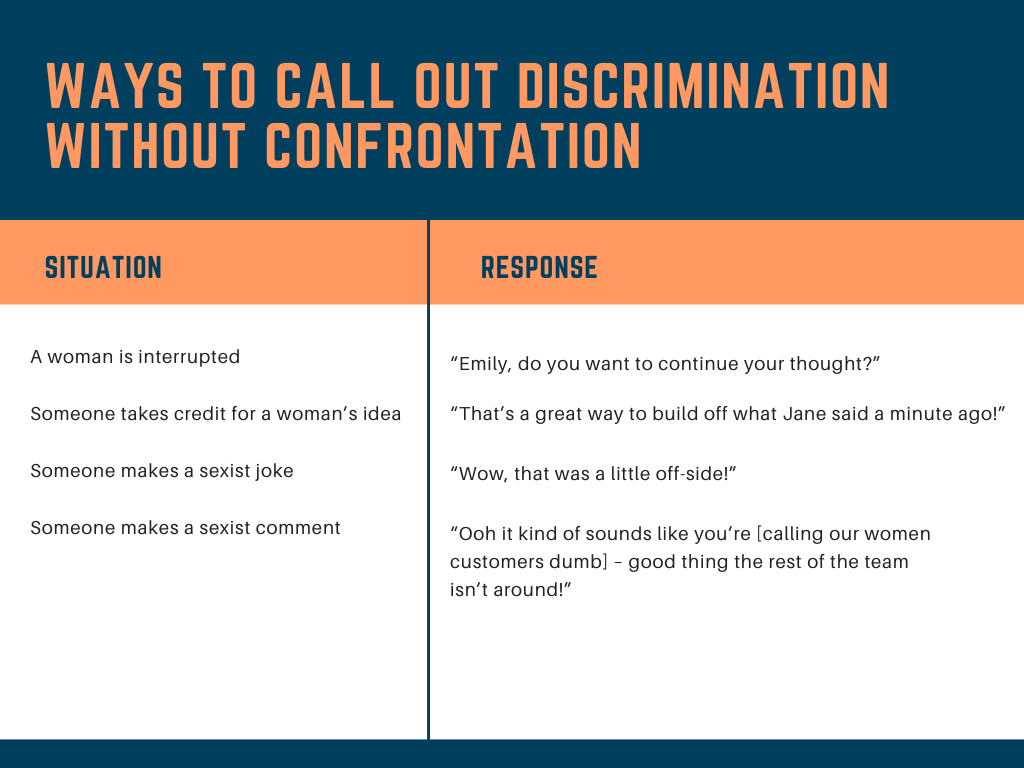How To Say What Needs To Be Said
In a study of Harvard Business School alumni, more than 40% of men said they believed gender had been an advantage in their careers (Ammerman & Groysberg, 2021). However, despite feeling aware of gender biases and wanting to support the women around them, many men feel uncertain as to how to do so.
“Even for men who want to engage, there’s a natural question of whether we should be the people taking the lead on trying to solve these problems or whether we should be living the values of equity and stepping back so women can lead instead,” said Matt Piltch, as quoted by Ammerman & Groysberg.
The fact is, men’s voices are critical because of, not in spite of, their gender. In fact “scholars who study diversity advocacy have found that men’s efforts to combat sexism or support gender inclusion are often seen as more legitimate and viewed more favorably than women’s (Ammerman & Groysberg, 2021).
Here are three ways to call out gender discrimination.
Say Something When You See Something
Speaking up against discrimination is extremely uncomfortable, especially when the perpetrator is your peer. According to one study on gender discrimination in the workplace, the number-one action that women said was important for male allies to do was calling out instances of gender discrimination. Unfortunately, this action was ranked near the bottom of men’s lists. When men were asked how they support women, few reported speaking up against discrimination when they see it (Ammerman & Groysberg, 2021). Although it may feel uncomfortable, calling out discrimination in the moment demonstrates your allyship to the victim and is highly effective at catalyzing real cultural change.
Start The Conversation
Discrimination isn’t always explicit and can often take more subtle forms such as a lack of recognition, lack of representation, or higher expectations (read How to identify Gender Discrimination). Upon recognizing these symptoms, men should feel empowered to start the conversation. This allows men to leverage their social network and social capital to create more space for women. For example, “Hey Jim, I noticed there aren’t any women in your department. Have you considered why this might be?”
Get Involved Proactively
Men are half as likely as women to spend substantial time on DE&I work that falls outside their formal job responsibilities – work such as supporting employee resource groups, organizing events, and recruiting employees from underrepresented groups. They are also less likely to take allyship actions such as mentoring women of color, advocating for new opportunities for them, and actively confronting discrimination (Burns, Huang, Krivkovich, Rambachan, Trkulja, Yee, 2021).
Becoming involved, or starting initiatives from scratch, demonstrates one’s allyship to team members who belong to marginalized groups and creates opportunity for change on a grander scale. Note that involving yourself in such an initiative does not require you to speak on behalf of the group you are representing.
One way to overcome the imposter syndrome that many male allies face is to remember that you too fall victim to gender discrimination. “Not only is men’s participation necessary to change the practices and norms that limit women’s advancement, but men themselves also stand to gain from disrupting the status quo. The gender hierarchy that disadvantages women creates pitfalls for men, who are penalized if they don’t adhere to an idealized and rigid standard of male behavior” (Ammerman & Groysberg, 2021). Therefore, by advocating for gender equality, we are advocating for everyone.
SOURCES
Ammerman, C., Colleen, & Groysberg, B., (2021). Glass Half-Broken : Shattering the Barriers That Still Hold Women Back at Work, Harvard Business Review Press.
Burns, T., Huang, J., Krivkovich, A., Rambachan, I., Trkulja, T., & Yee, L. (2021). Women In The Workplace 2021. McKinsey & Company. https://www.mckinsey.com/featured-insights/diversity-and-inclusion/women-in-the-workplace


